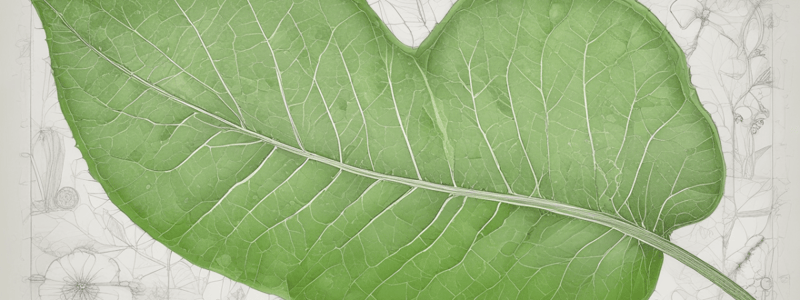Podcast
Questions and Answers
What is the primary function of the waxy cuticle in a leaf?
What is the primary function of the waxy cuticle in a leaf?
- To capture light for photosynthesis
- To protect the plant against herbivory
- To reduce water loss from the leaves (correct)
- To facilitate gas exchange
Which layer of the leaf contains the most chloroplasts?
Which layer of the leaf contains the most chloroplasts?
- Palisade mesophyll (correct)
- Upper epidermis
- Lower epidermis
- Spongy mesophyll
What is the role of trichomes in the epidermis?
What is the role of trichomes in the epidermis?
- To prevent water loss
- To protect the plant against herbivory (correct)
- To capture light for photosynthesis
- To increase gas exchange
What is the main role of chloroplasts in plant cells?
What is the main role of chloroplasts in plant cells?
What is the function of the spongy mesophyll?
What is the function of the spongy mesophyll?
What is the purpose of the stomata in the lower epidermis?
What is the purpose of the stomata in the lower epidermis?
Which layer of the leaf is responsible for producing the waxy cuticle?
Which layer of the leaf is responsible for producing the waxy cuticle?
What is the function of the palisade mesophyll?
What is the function of the palisade mesophyll?
What is the primary function of chlorophyll in a plant cell?
What is the primary function of chlorophyll in a plant cell?
Why are palisade mesophyll cells located near the top of the leaf?
Why are palisade mesophyll cells located near the top of the leaf?
What is the function of the xylem in a plant?
What is the function of the xylem in a plant?
What is the purpose of the root hair cells in a plant?
What is the purpose of the root hair cells in a plant?
What is the primary function of the phloem in a plant?
What is the primary function of the phloem in a plant?
Why do chloroplasts orientate themselves to best suit the available light?
Why do chloroplasts orientate themselves to best suit the available light?
What is the significance of the presence of starch in a leaf?
What is the significance of the presence of starch in a leaf?
What is the purpose of the spongy mesophyll layer in a leaf?
What is the purpose of the spongy mesophyll layer in a leaf?
What is the function of the stomata (pores) in a leaf?
What is the function of the stomata (pores) in a leaf?
What is the significance of the xylem tree rings?
What is the significance of the xylem tree rings?
Study Notes
Leaf Structure
- A cross-section of a leaf consists of several layers: clear waxy cuticle, upper epidermis, palisade mesophyll, spongy mesophyll, and guard cells surrounding stomata in the lower epidermis.
- The waxy cuticle is transparent, reducing water loss from the leaves and produced by epidermal cells.
- The upper epidermis is a thin layer of cells that allows light to pass through, without containing chloroplasts.
- Some epidermal cells may be modified to form trichomes, which help protect the plant against herbivory.
Palisade Mesophyll and Spongy Mesophyll
- The palisade mesophyll is a tightly packed layer of cells containing many chloroplasts, capturing light for photosynthesis.
- The spongy mesophyll has large air spaces between cells, allowing for gas exchange and containing chloroplasts to capture light.
Chloroplasts and Photosynthesis
- Chloroplasts are specialized organelles in plant cells, carrying out photosynthesis and containing the photosynthetic pigment chlorophyll.
- Chloroplasts are mainly located in the mesophyll layers, with 10 to 100 chloroplasts per cell.
- Chloroplasts can orientate themselves to optimize light absorption, spreading out in low light conditions and aligning vertically in high light conditions.
Leaf Adaptations
- The large surface area of a leaf increases light absorption.
- A thin epidermis and waxy cuticle allow more light to reach photosynthetic cells while protecting the leaf and reducing water loss.
- Palisade cells contain many chloroplasts to absorb available light, and the spongy mesophyll allows carbon dioxide to diffuse easily into the leaf.
Plant Systems
- The shoot system includes the leaves, stems, flowers, buds, and fruit, carrying water and nutrients from the roots to the leaves.
- The root system anchors the plant, absorbs minerals and water, and has a large surface area due to root hair cells.
- Xylem transports water and dissolved minerals throughout the plant, moving in one direction (upwards).
- Phloem transports glucose and nutrients to all cells in the plant, moving in two directions (up and down the plant's stem).
Xylem and Phloem
- Xylem is a one-way system, transporting water from the roots to the highest leaf, and its cells die after one year.
- Phloem is a two-way system, transporting glucose and nutrients throughout the plant, and its cells remain alive.
Studying That Suits You
Use AI to generate personalized quizzes and flashcards to suit your learning preferences.
Description
Explore the layers and functions of a leaf, including the cuticle, epidermis, mesophyll, and stomata. Learn how the leaf's structure enables photosynthesis and reduces water loss.




